American Sniper fake baby: I run a child actor agency and it's clear why they went for a dummy
Babies present a director's greatest challenge

So a media screening audience laughed out loud at the American Sniper “fake baby”?
That’s hardly surprising if you watch the scene in question, as the mechanical baby used is obviously a fake. Nowadays audiences of film and television drama are used to absolute reality. And they won’t accept anything less.
Viewers have become so accustomed to the magic of the screen, that even a talking bear interacting with humans, or a murderous giant primate holding one in its hand, need to be utterly convincing on celluloid. So a human baby – well, it can’t be anything less than real.
But actually, a human baby is probably the greatest challenge for a producer and a director, let alone the actors. This is not because you can’t get them. You can, of course. Many agencies that specialise in providing child actors for professional productions for stage and screen also have babies on their books - of all sizes, ages and ethnicities.
My agency has around 50 babies on our books at any time. We have placed one or two babies every week in productions, including Holby City and Call the Midwife. We even had a regular baby appearing in Eastenders (baby Amy) for three years.
We’re always looking for babies, and newborns are very in demand. As are twins, and triplets even more so. We signed up 15-week-old triplets in the past - they are like gold dust.
No, the reason that using a real baby is so fraught with difficulties is because of the licensing laws in place to protect children.
In the UK there are very strict rules for how many hours a baby can be at their place of performance, for the time in the morning they can begin and the time in the afternoon they must finish by, for how long they are allowed on set and so on. They must take a “rest” every 30 minutes, for example. This is why soap operas like to use twins for a baby character – so they can swap them around and not have to halt filming so often.
Film sets are highly pressurised environments that are usually costed out by the week or month, not by the hour. The heat is on the production team to complete the filming within a certain number of days or weeks so the costs do not spiral out of control, and as a result everyone is working long, hard hours, including the actors.
But babies can’t, of course. And there lies the problem.
Soap operas use real babies, but they know where they are filming and when; they have rigorous schedules mapped out in advance – everything is much more structured: they are well-oiled machines.
Big Hollywood films are less so. The director may have a change of plan, last-minute. They may want to re-shoot a scene with little notice. A real baby would be a nuisance in these cases.
So I can see why the director of a film, or a play on stage may be tempted to use a fake baby. But this strategy has backfired for Clint Eastwood and the fake baby hype may even start to overshadow the Oscar hype. At the time of writing this, #fakebaby is in serious danger of trending on Twitter.
I think the real question is, in a film with such a good script, outstanding director, and brilliant actors, why did they use such a bad fake baby?
Warren Bacci is the Director of the Top Talent Agency


Join our commenting forum
Join thought-provoking conversations, follow other Independent readers and see their replies